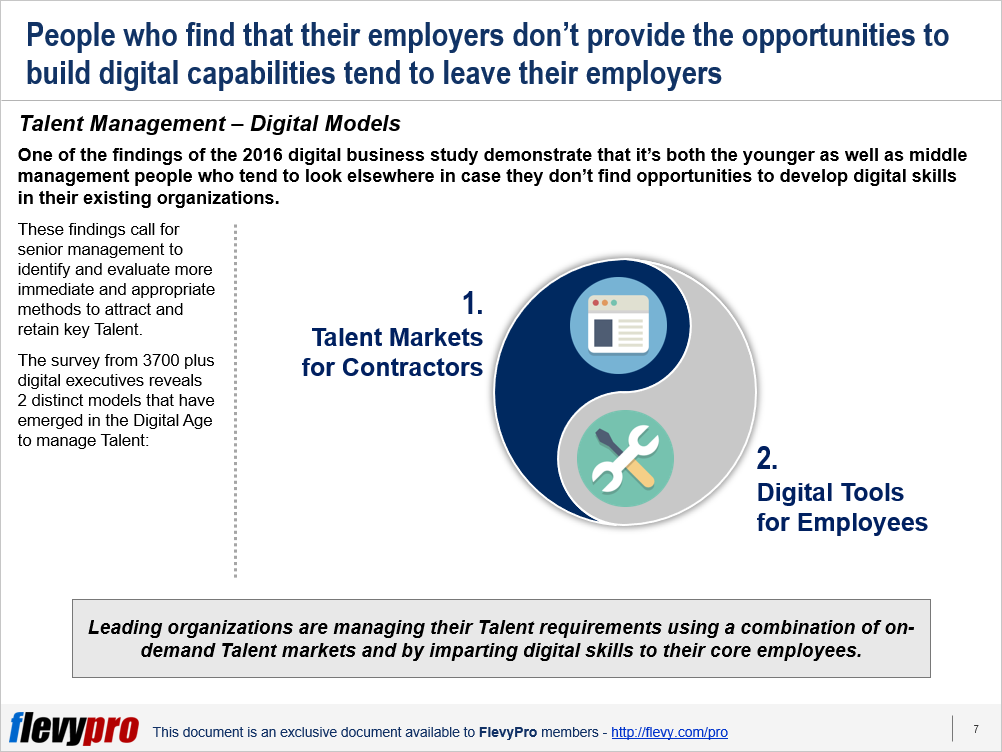Traditional Talent Management practices fail to meet the high-potential talent requirements imperative to compete in the digital world today. In fact, they disappoint the key talent available in the market.
A 2016 Digital Business research by MIT Sloan Management Review and Deloitte on 3700+ executives reveals attracting and retaining talent as the most pressing concern for organizations large or small. The study indicates that organizations that are still using traditional approaches to manage Talent face a number of pressing challenges, including:
- Building new competencies within limited resources.
- Alignment of culture, strategic initiatives, human capital, and hierarchies with organizational objectives.
- Attracting, selecting, and retaining key talent.
- Creating robust Performance Management, compensation, and benefits systems.
- Finding and developing talent with critical capabilities—such as forward thinking, transformative vision, and change focus—alongside technical skills.
- Providing opportunities that require digital skills, to attract and keep critical Talent engaged in the organization.
One of the findings of the 2016 digital business study demonstrate that it’s both the younger as well as middle management people who tend to look elsewhere in case they don’t find opportunities to develop digital skills in their existing organizations. Such results call for senior management to identify, evaluate, and implement more immediate and appropriate digital technologies methods to attract and retain key talent. Leading organizations are now incorporating these Talent Transformation efforts into their Digital Transformation programs.
Research on 3700 plus Digital-native respondents further reveals leading organizations to be using a combination of 2 distinct models to manage their Talent:
- Talent Markets for Contractors
- Digital Tools for Employees
Let's discuss the first approach to Talent Management in detail, for now.
Talent Markets for Contractors
Acquisition of right talent necessitates fostering linkages with on-demand talent markets for the timely availability of required talent. Many organizations seek help from on-demand Talent Markets to attract and sustain talent in the digital business environment. These organizations pursue a flexible recruitment model using digital platforms to attract skilled contractors and consultants. Digital talent markets can be expanded or contracted depending on the quantity of work and skillsets required.
Digital talent markets can coordinate the work of full-time employees as well as cover live activities of contractors more nimbly and reliably. Digital platforms offer superior talent markets to assess and manage large talent pool of contractors. A few organizations are experimenting with developing their own on-demand talent markets while some have cooperated with other organizations to share talent markets. It’s up to senior management to decide if they want to leverage existing on-demand talent markets or cultivate their own to ensure availability of required skills when needed. Talent markets can be nurtured using 3 best practices:
- Manage on-demand talent markets as a community
- Strike a balance between full-time and part-time talent
- Create an environment where the best people want to work
Manage on-demand talent markets as a community
To make the availability of required key talent certain:
- On-demand talent markets should be considered strategic resources and cultivated carefully with future talent requirements in mind.
- Companies should devote resources and efforts to develop their own talent pool.
Strike a balance between full-time and part-time talent
Talent markets are meant to manage freelancers. However, a few organizations have also begun collaborating with them and deploying their full-time employees to project work that is critical to build new competences. A few considerations in this regard include:
- Companies need to strike an equilibrium between full-time and part-time talent.
- Some people prefer full-time employment while others fancy flexibility or work from home options.
- Some workforce providers even offer services of retired people with expert skills, who have proved to be a valuable asset.
- Firms can choose on-demand workforce providers to have full-time employees to maintain a steady employee base, or pick part-time contractors to handle workload surges.
Create an environment where the best people want to work
Setting up the right environment is central to attracting and retaining the best flexible, on-demand talent. A majority of companies consider freelancers or independent contractors inferior to their permanent employees. Organizations that want to attract great talent should think of contractors as valuable resources and treat them as such. To get top talent, organizations need to:
- Nurture an Organizational Culture conducive to support on-demand workers.
- Devise remuneration and reward systems that value contractors and full-time employees equally.
- Create an atmosphere that offers attractive work experiences for the employees.
- Deploy people on interesting projects and allow them to experience job rotations to improve their skills sets, problem solving abilities, cross-departmental team collaboration, and improve their engagement levels.
Interested in learning more about the 2 distinct approaches to Talent Management through Digital Transformation? You can download an editable PowerPoint on Digital Transformation: Talent Management here on the Flevy documents marketplace.
Are you a Management Consultant?
You can download this and hundreds of other consulting frameworks and consulting training guides from the FlevyPro library.

Comments